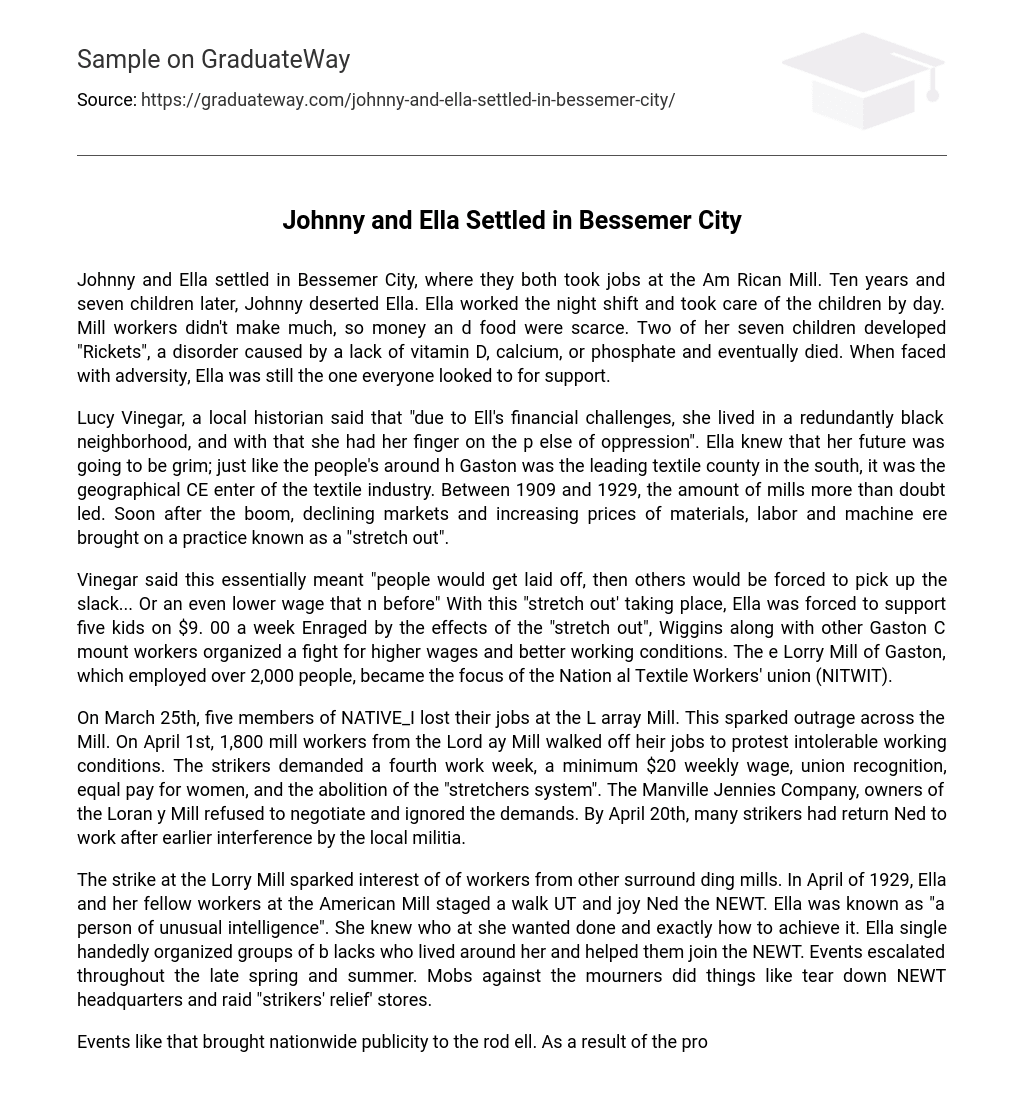Johnny and Ella settled in Bessemer City, where they both took jobs at the Am Rican Mill. Ten years and seven children later, Johnny deserted Ella. Ella worked the night shift and took care of the children by day. Mill workers didn’t make much, so money an d food were scarce. Two of her seven children developed “Rickets”, a disorder caused by a lack of vitamin D, calcium, or phosphate and eventually died. When faced with adversity, Ella was still the one everyone looked to for support.
Lucy Vinegar, a local historian said that “due to Ell’s financial challenges, she lived in a redundantly black neighborhood, and with that she had her finger on the p else of oppression”. Ella knew that her future was going to be grim; just like the people’s around h Gaston was the leading textile county in the south, it was the geographical CE enter of the textile industry. Between 1909 and 1929, the amount of mills more than doubt led. Soon after the boom, declining markets and increasing prices of materials, labor and machine ere brought on a practice known as a “stretch out”.
Vinegar said this essentially meant “people would get laid off, then others would be forced to pick up the slack… Or an even lower wage that n before” With this “stretch out’ taking place, Ella was forced to support five kids on $9. 00 a week Enraged by the effects of the “stretch out”, Wiggins along with other Gaston C mount workers organized a fight for higher wages and better working conditions. The e Lorry Mill of Gaston, which employed over 2,000 people, became the focus of the Nation al Textile Workers’ union (NITWIT).
On March 25th, five members of NATIVE_I lost their jobs at the L array Mill. This sparked outrage across the Mill. On April 1st, 1,800 mill workers from the Lord ay Mill walked off heir jobs to protest intolerable working conditions. The strikers demanded a fourth work week, a minimum $20 weekly wage, union recognition, equal pay for women, and the abolition of the “stretchers system”. The Manville Jennies Company, owners of the Loran y Mill refused to negotiate and ignored the demands. By April 20th, many strikers had return Ned to work after earlier interference by the local militia.
The strike at the Lorry Mill sparked interest of of workers from other surround ding mills. In April of 1929, Ella and her fellow workers at the American Mill staged a walk UT and joy Ned the NEWT. Ella was known as “a person of unusual intelligence”. She knew who at she wanted done and exactly how to achieve it. Ella single handedly organized groups of b lacks who lived around her and helped them join the NEWT. Events escalated throughout the late spring and summer. Mobs against the mourners did things like tear down NEWT headquarters and raid “strikers’ relief’ stores.
Events like that brought nationwide publicity to the rod ell. As a result of the prolonged strikes, the Manville Jennies Company retaliated with major eve actions from many housing; but that didn’t affect the spirit of the inner, they just bull t “tent colonies”. On June 7th, 1929, 150 workers marched to the mill to call out the night shift. These workers formed a picket line; which was broken up by the police. This disrupts on sparked a shooting in the “tent colony’. It injured four policemen and one unionist.
Seven ant one unionists were arrested. Of those seventy one, sixteen were taken to trial. On September ere 9th, a mistrial was declared. That evening, an angry mob of over one hundred men formed in re spoons to the similar of the case, wrecked the Newt’s headquarters in Gaston and Bess seems City, and terrorized, kidnapped, flogged, and threatened to kill several union members. The next day, the mob regrouped and raided the headquarters of the International Labor Defer ones (LID) due to their part in the Anthill case.
To protest these unruly actions, the NITWIT announced a huge rally for September 14. Ella was known as a balladeer. As the events of the strike unfolded, Ella record deed them in song. She used the strike, the union, and the men and women in jail all as sub ejects of her meaningful ballads. Folklorist Margaret Larkin said her songs Were “better that n a hundred speeches” Ell’s spirit is captivated in her ballad “The Mill Mothers Lament” We leave our homes in the morning, We kiss our children good bye, While we slave for the bosses, Our children scream and cry.
But understand, all workers, Our union they do fear, Let’s stand together, workers, And have a union here. This ballad embodied her faith in the union. On September 14th, the day of the aforementioned NITWIT protest, The Minivan Ill Jesses company sent out a embroiled force of deputies and vigilantes. This band of en was sent to disperse those attending the rally. A group of twenty two unarmed mourners with Ella among them, rode by truck from Bessemer City to the rally site. The truck was halted at a roadblock and armed men forced the workers to return to Bessemer.
The truck headed back the other way, doing as the armed men demanded only to be chased down by multiple Carlo ads of armed men, one of which cut off the truck of mourners. The truck driver couldn’t brake fast enough and hit the car. Workers soon started to come out of the back of the truck. As Ella got out , the mob opened ire and she fell into the truck bed and gasped “Oh, my God, they’ve shot me” Union leaders were certain that Ella was targeted for her key role in the strikes.





